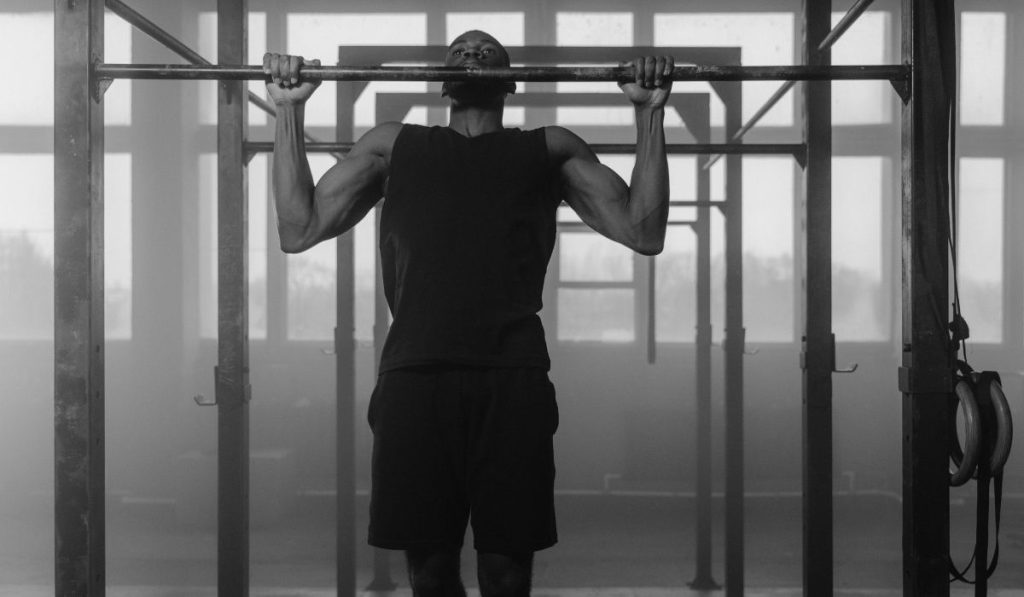Have you ever wanted to conquer a challenging upper body workout that targets multiple muscle groups at once? If so, the barbell pull-up may be just what you’re looking for. This exercise involves using a barbell to perform a pull-up, adding an extra layer of difficulty and resistance to the traditional bodyweight pull-up.
Not only does the barbell pull-up work your back, biceps, and shoulders, but it also engages your core and improves grip strength. By incorporating this exercise into your workout routine, you can develop upper body strength and endurance, ultimately helping you to achieve your fitness goals.
In this blog post, we’ll dive deeper into the benefits of the barbell pull-up and share tips for proper technique and form. Whether you’re a seasoned gym-goer or a beginner looking to level up your workouts, this post will provide valuable insights and guidance for mastering this challenging exercise. So, grab your barbell and let’s get started!
Read More About Deca Durabolin Benefits
Benefits of Barbell Pull Ups
Here are some of the benefits of barbell pull-ups:
- Target multiple muscle groups: Barbell pull-ups target your back, biceps, and shoulders, helping to build upper body strength and definition.
- Improved grip strength: Holding onto a barbell during a pull-up requires significant grip strength, which can improve your overall grip strength and ability to perform other exercises.
- Engage your core: Performing a barbell pull-up also engages your core muscles as you lift your body weight, helping to improve core strength and stability.
- Progression from traditional pull-ups: Once you’ve mastered traditional pull-ups, the added resistance from the barbell can provide an additional challenge and help to further build upper body strength.
- Can be modified for various fitness levels: The use of bands or assistance machines can be used to modify the exercise for those with limited upper body strength, while the addition of weight plates can be used to make the exercise more challenging for advanced lifters.
Incorporating barbell pull-ups into your workout routine can have significant benefits for overall upper body strength and endurance.

Proper Technique and Form
Proper technique and form are crucial when performing barbell pull-ups to prevent injury and maximize the benefits of the exercise. Here are some key tips to keep in mind:
- Setting up the barbell: Adjust the barbell to the appropriate height for your height and the exercise you’re performing. Make sure the barbell is secure and won’t move during the exercise.
- Grip position: Grip the barbell with your palms facing away from you (overhand grip) and hands slightly wider than shoulder-width apart.
- Range of motion: Lower yourself until your arms are fully extended, then pull yourself up until your chin clears the bar. Lower yourself back down to the starting position in a controlled manner.
- Common mistakes to avoid: Avoid using momentum to swing your body up to the bar. Instead, use your upper body strength to pull yourself up. Keep your core engaged throughout the exercise to prevent swinging or arching your back. Make sure your elbows stay close to your body throughout the movement.
- Breathing: Exhale as you pull yourself up and inhale as you lower yourself back down.
Proper technique and form can be difficult to master, especially if you’re new to barbell pull-ups. Don’t be afraid to seek guidance from a certified personal trainer or experienced gym-goer to ensure you’re performing the exercise correctly.
Read More About Trenbolone Dosage for Beginners
Barbell Pull-Up Variations
Assisted pull-ups
Assisted pull-ups are a great variation of barbell pull-ups that can help beginners build up the strength needed to perform a full pull-up. These variations can also help intermediate and advanced lifters perfect their form and build endurance.
Assisted pull-ups can be performed using a variety of equipment, including resistance bands or an assisted pull-up machine. Using resistance bands involves looping the band around the bar and then placing one or both feet into the loop to reduce the amount of weight you need to lift. An assisted pull-up machine involves adjusting the weight to offset your body weight, making the exercise easier.
When performing assisted pull-ups, it’s important to maintain proper form and technique. Engage your core and keep your elbows close to your body throughout the movement. Lower yourself in a controlled manner and avoid using momentum to swing your body up to the bar.
Weighted pull-ups
Weighted pull-ups are a great way to increase the difficulty of the barbell pull-up exercise and build upper body strength. This variation involves adding weight plates to a belt or vest to increase the resistance of the exercise.
When performing weighted pull-ups, it’s important to start with a weight that you can handle and gradually increase the weight as you become stronger. Use proper form and technique, keeping your core engaged and elbows close to your body throughout the movement.
Weighted pull-ups can also be performed with a neutral grip (palms facing each other) or a wide grip (hands wider than shoulder-width apart) to target different muscle groups.
Neutral grip pull-ups
Neutral grip pull-ups are another variation of barbell pull ups that can target different muscle groups and reduce strain on the wrists and shoulders. This variation involves using parallel handles that allow for a neutral grip, with palms facing each other.
Neutral grip pull-ups target the same muscle groups as traditional pull-ups, including the back, biceps, and shoulders. However, this variation can be easier on the wrists and shoulders, making it a good option for those with previous injuries or discomfort in those areas.
To perform neutral grip pull-ups, use proper form and technique, keeping your core engaged and elbows close to your body throughout the movement. This variation can also be performed with added weight to increase the difficulty and build upper body strength.
One-arm pull-ups
One-arm pull-ups are an advanced variation of barbell pull-ups that require significant upper body strength and control. This variation involves lifting your entire body weight with one arm while holding onto the barbell with the other hand.
To perform a one-arm pull-up, start by gripping the barbell with one hand and hanging with your arm fully extended. Use your other arm to support yourself on a nearby object, such as a door frame or bar. Slowly lift your body up using your one arm, keeping your core engaged and elbow close to your body. Lower yourself back down in a controlled manner.
One-arm pull-ups require a lot of strength and practice to master. It’s important to start with assisted variations and gradually work your way up to a full one-arm pull-up. Proper form and technique are crucial to prevent injury and maximize the benefits of this exercise.
Tips for Beginners
If you’re new to barbell pull-ups, it’s important to start with proper technique and form and gradually build up your strength and endurance. Here are some tips for beginners:
- Start with assisted pull-ups: Use resistance bands or an assisted pull-up machine to reduce the amount of weight you need to lift and gradually build up your strength.
- Practice proper form and technique: Engage your core, keep your elbows close to your body, and avoid using momentum to swing your body up to the bar.
- Build up slowly: Start with a few reps at a time and gradually increase the number of reps and sets as you become stronger. Don’t push yourself too hard and risk injury.
- Incorporate other exercises: Along with barbell pull-ups, incorporate other exercises that target your back, biceps, and shoulders to build overall upper body strength.
- Be patient and consistent: Building strength and endurance takes time and consistent effort. Don’t get discouraged if you don’t see results right away, and be patient with yourself as you work towards your goals.
- Seek guidance if needed: If you’re unsure about proper form and technique, or if you have any pre-existing injuries, seek guidance from a certified personal trainer or healthcare professional.
By following these tips, beginners can build up their strength and endurance and eventually master the barbell pull-up exercise. Remember to always prioritize proper form and technique to prevent injury and maximize the benefits of this challenging exercise.
Read More About Trenbolone Price

Sample Barbell Pull Up Workout Routine
Here’s a sample barbell pull-up workout routine that can be tailored to your fitness level and goals:
Warm-up:
- 5-10 minutes of cardio to get your heart rate up
- Dynamic stretches to warm up your upper body muscles, such as arm circles, shoulder shrugs, and wrist rotations.
Main workout:
- Assisted pull-ups: 3 sets of 8-10 reps using resistance bands or an assisted pull-up machine. Focus on proper form and technique and gradually reduce the assistance as you become stronger.
- Barbell pull-ups: 3 sets of 5-8 reps. Use proper form and technique, keeping your core engaged and elbows close to your body throughout the movement.
- Weighted pull-ups: 3 sets of 5-8 reps. Add weight plates to a belt or vest to increase the resistance of the exercise.
- Neutral grip pull-ups: 2 sets of 8-10 reps. Use parallel handles that allow for a neutral grip, with palms facing each other.
- One-arm pull-up practice: 2 sets of assisted variations or negative reps. Use a door frame or bar to support yourself with one arm while you lift yourself with the other arm.
Cool-down:
- Static stretches to stretch your upper body muscles, such as a chest stretch, triceps stretch, and shoulder stretch.
- Foam rolling or other self-massage techniques to release tension in your muscles.
Remember to adjust the sets and reps based on your fitness level and gradually increase the weight and difficulty of the exercise as you become stronger. Don’t forget to rest and recover between workouts to prevent injury and promote muscle growth.
Conclusion
In conclusion, the barbell pull up is a challenging and effective exercise that can help build upper body strength and endurance. With proper technique and form, this exercise can target multiple muscle groups, improve grip strength, and engage your core. There are also several variations of barbell pull-ups, including assisted pull-ups, weighted pull-ups, neutral grip pull-ups, and one-arm pull-ups, that can be modified to suit your fitness level and goals.
When incorporating barbell pull-ups into your workout routine, it’s important to start with proper form and gradually build up your strength and endurance. Consistency and patience are key when it comes to achieving your fitness goals.
By following the tips and workout routine provided in this article, you can improve your upper body strength and endurance and master the challenging barbell pull-up exercise. Remember to always prioritize proper form and technique to prevent injury and maximize the benefits of this exercise.


No responses yet